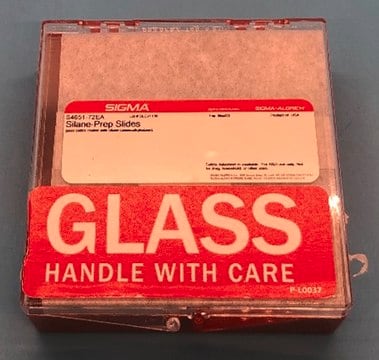Yes. Silane Prep slides, Product No. S4651, are produced using A3648. These slides have an expiration period of 24 months.
A3648
(3-Aminopropyl)triethoxysilane
≥98%
Synonym(s):
APTS, 3-Triethoxysilylpropylamine, APTES
Select a Size
About This Item
Recommended Products
Quality Level
Assay
≥98%
form
liquid
pH
11 (20 °C, 20 g/L)
bp
217 °C/760 mmHg (lit.)
mp
220-222 °C
density
0.946 g/mL at 25 °C (lit.)
application(s)
diagnostic assay manufacturing
hematology
histology
storage temp.
room temp
SMILES string
CCO[Si](CCCN)(OCC)OCC
InChI
1S/C9H23NO3Si/c1-4-11-14(12-5-2,13-6-3)9-7-8-10/h4-10H2,1-3H3
InChI key
WYTZZXDRDKSJID-UHFFFAOYSA-N
Looking for similar products? Visit Product Comparison Guide
Application
Biochem/physiol Actions
Signal Word
Danger
Hazard Statements
Precautionary Statements
Hazard Classifications
Acute Tox. 4 Oral - Eye Dam. 1 - Skin Corr. 1B - Skin Sens. 1
Storage Class Code
8A - Combustible corrosive hazardous materials
WGK
WGK 1
Flash Point(F)
199.4 °F - closed cup
Flash Point(C)
93 °C - closed cup
Personal Protective Equipment
Choose from one of the most recent versions:
Already Own This Product?
Find documentation for the products that you have recently purchased in the Document Library.
Customers Also Viewed
-
Can I buy glass slides already treated with Product A3648, (3-Aminopropyl)triethoxysilane?
1 answer-
Helpful?
-
-
How does Product A3648, (3-Aminopropyl)triethoxysilane, compare to poly-L-lysine for binding tissue to glass surfaces?
1 answer-
This product has been cited as being a better tissue adhesive than poly-L-lysine. Maddox PH, Jenkins D., 3-Aminopropyltriethoxysilane (APES): a new advance in section adhesion. J Clin Pathol., 40(10):1256-7 (1987).
Helpful?
-
-
What is the concentration of the (3-Aminopropyl)triethoxysilane, commonly known as APTES?
1 answer-
The (3-Aminopropyl)triethoxysilane, which is a neat liquid, is 4.3 M. This is based on a density of 0.946 g/mL and a molecular weight of 221.37.
Helpful?
-
-
Can Product A3648, (3-Aminopropyl)triethoxysilane, be used to coat controlled pore glass?
1 answer-
To coat controlled-pore glass beads for affinity chromatography, the following method is recommended:1. Treat 1 g of clean beads with 20 mL of a 10% aqueous A3648 (pH 3 to 4) at 75 °C for 2 hours.2. Filter the beads to remove the solution and dry overnight in a 115 °C oven. See: J. Dairy Sci., 73, 2720-2730 (1990).
Helpful?
-
-
What is the Department of Transportation shipping information for this product?
1 answer-
Transportation information can be found in Section 14 of the product's (M)SDS.To access the shipping information for this material, use the link on the product detail page for the product.
Helpful?
-
-
Can the coating made from product A3648, (3-Aminopropyl)triethoxysilane, be removed?
1 answer-
For Product A3648, (3-Aminopropyl)triethoxysilane, the siliconized coating can be removed by an overnight treatment with 10-20% (w/v) aqueous or alcoholic potassium hydroxide or sodium hydroxide solutions. It may also be possible to remove the coating by physical abrasion, i.e., scrubbing or vigorously brushing the glass surface. Autoclaving will not destroy the coating.
Helpful?
-
Active Filters
Our team of scientists has experience in all areas of research including Life Science, Material Science, Chemical Synthesis, Chromatography, Analytical and many others.
Contact Technical Service








![N-[3-(Trimethoxysilyl)propyl]ethylenediamine 97%](/deepweb/assets/sigmaaldrich/product/structures/149/508/f87a9a89-f138-4c5e-9fe0-6561914241c3/640/f87a9a89-f138-4c5e-9fe0-6561914241c3.png)




